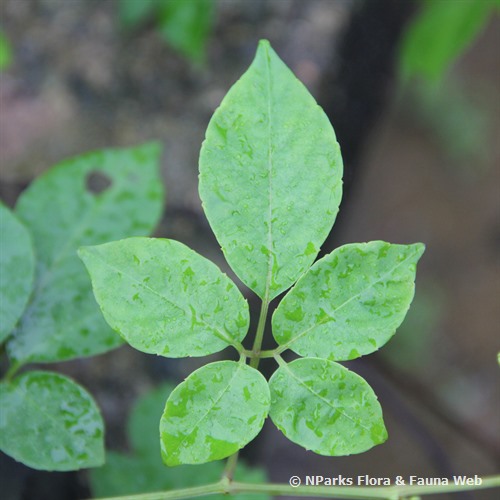.jpg)
Back
Causonis trifolia (L.) Mabb. & J.Wen
| Family Name: | Vitaceae |
| Synonyms: | Cissus carnosa Lam., Vitis trifolia L., Cayratia trifolia (L.) Domin |
| Common Name: | Three-Leaved Wild Vine |
Causonis trifolia is a native climber of Singapore. It has trifoliate leaves with scalloped-shaped leaf edges and reddish stems when young. It has fleshy smooth berries that ripen from green to black.
Name
Classifications and Characteristics
| Plant Division | Angiosperms (Flowering Seed Plants) (Dicotyledon) |
|---|---|
| Plant Growth Form | Climber |
| Lifespan (in Singapore) | Perennial |
| Mode of Nutrition | Autotrophic |
Biogeography
| Native Distribution | Tropical and Subtropical Asia to Western Pacific. |
|---|---|
| Native Habitat | Terrestrial (Primary Rainforest, Secondary Rainforest, Coastal Forest, Freshwater Swamp Forest, Grassland / Savannah/ Scrubland, Disturbed Area / Open Ground) |
| Preferred Climate Zone | Tropical, Sub-Tropical / Monsoonal |
Description and Ethnobotany
| Growth Form | It is a herbaceous climber which grows by twining around a source of support or by the use of tendrils to climb up taller objects. |
|---|---|
| Foliage | Its spirally arranged, compound stalked leaves have three toothed-margined leaflets (3-foliolate). The terminal leaflet blade is drop-shaped, oblong to oval, and 5.5–7 by 3.5–4.5 cm. The lateral leaflet is oval and 3.5–5.5 by 3–4 cm. Leaf base cuneate to rounded, apex acute to acuminate. Petiole is 1- 6 cm long. Tendrils are slender and wiry. |
| Stems | Stem is 1 - 4 mm in diameter, highly branched, hairy with pale hair. |
| Flowers | Its stalked flowering shoot is up to 2 cm across and found in the leaf axils. |
| Fruit | Its fruits are smooth, disc-shaped berries, 0.5– 1.5 cm wide, and contain 2–4 triangular seeds each. Its seed is 5–6 x 4.5–5 mm. |
| Habitat | It grows on the fringes of lowland dipterocarp and swamp forests, by streams, on rocks, in wasteland near the sea, and near inhabited areas at around 70–1300 m altitude. |
| Associated Fauna | Its flowers are pollinated by bees, and butterflies, and its fruits and seeds may be eaten and dispersed by birds. |
| Cultivation | It can be propagated by from stem cuttings and seeds. However, germination from seeds takes 1–3 months. |
| Etymology | Latin Cayratia, from the Annamese vernacular name, cay-rat, a vine; Latin tri, three, Latin folium, leaf, referring to the leaves bearing 3 leaflets |
| Ethnobotanical Uses | Edible Plant Parts : Edible Leaves Food (Fruit or Vegetable): The young leaves are eaten as a vegetable. Medicinal: The plant can be used as a poultice for ulcerated nose or as a rubefacient, A decoction is used for fever, the juice is used to treat itch on the head. |
Landscaping Features
| Landscaping | It is suitable for growing in parks on trellises and pergolas. |
|---|---|
| Desirable Plant Features | Ornamental Foliage, Ornamental Fruits |
| Landscape Uses | General, Parks & Gardens, Coastal, Trellis / Arbour / Pergola |
Fauna, Pollination and Dispersal
| Fauna Pollination Dispersal Associated Fauna | Bird-Attracting, Butterfly-Attracting |
|---|---|
| Pollination Method(s) | Biotic (Fauna) |
| Seed or Spore Dispersal | Biotic (Fauna) (Vertebrates (Other Mammal)) |
Plant Care and Propagation
| Light Preference | Full Sun |
|---|---|
| Water Preference | Moderate Water |
| Plant Growth Rate | Fast |
| Rootzone Tolerance | Moist Soils, Well-Drained Soils, Fertile Loamy Soils, Easy to Grow |
| Transplanting Tolerance | Good |
| Maintenance Requirements | Moderate |
| Propagation Method | Seed, Stem Cutting |
Foliar
| Foliage Retention | Evergreen |
|---|---|
| Mature Foliage Colour(s) | Green |
| Mature Foliage Texture(s) | Leathery |
| Prominent Young Flush Colour(s) | Green |
| Young Flush Texture(s) | Smooth |
| Foliar Modification | Foliar Tendril |
| Foliar Type | Compound (Trifoliate) |
| Foliar Arrangement Along Stem | Spiral |
| Foliar Attachment to Stem | Petiolate |
| Foliar Shape(s) | Non-Palm Foliage (Oval, Ovate) |
| Foliar Venation | Pinnate / Net |
| Foliar Margin | Crenate, Dentate |
| Foliar Apex - Tip | Acute, Acuminate |
| Foliar Base | Cuneate, Rounded / Obtuse |
Non - Foliar and Storage
| Stem Type & Modification | Climbing Tendril, Herbaceous |
|---|---|
| Root Type | Underground |
Floral (Angiosperm)
| Flower & Plant Sexuality | Bisexual Flowers |
| Flower Colour(s) | White, Cream / Off-White |
|---|---|
| Flower Grouping | Cluster / Inflorescence |
| Flower Location | Axillary |
| Flower Symmetry | Radial |
| Individual Flower Shape | Urceolate / Urn-shaped |
| Inflorescence Type | Corymb |
| Flowering Period | Free-Flowering |
Fruit, Seed and Spore
| Mature Fruit Colour(s) | Black |
|---|---|
| Mature Fruit Texture(s) | Smooth |
| Fruit Classification | Simple Fruit |
| Fruit Type | |
| Seed Quantity Per Fruit | Few (1-5) |
Image Repository
Others
| Master ID | 30794 |
|---|---|
| Species ID | 5148 |
| Flora Disclaimer | The information in this website has been compiled from reliable sources, such as reference works on medicinal plants. It is not a substitute for medical advice or treatment and NParks does not purport to provide any medical advice. Readers should always consult his/her physician before using or consuming a plant for medicinal purposes. |






